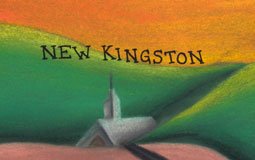| Return to Home Brief History of the hamlet of New Kingston
 The area known as New Kingston is located in the Town of Middletown, one of the oldest towns in Delaware County, being incorporated in 1789. New Kingston encompasses a 5,000 acre land grant set aside by Robert R. Livingston in 1799. Livingston conveyed lots within this tract to residents of Kingston who had lost their homes when the British burned the city after the Revolution. The land was divided into 100 acre lots of 50 acres each. This orderly, geometric pattern was imposed over an area that was characterized by three deep north-south hollows, thus making settlement within the original patent divisions difficult. Many of New Kingston’s initial settlers were Dutch. Jacob Van Benschoten was the first pioneer and he blazed a trail into the New Kingston Valley in the 1790s. However, between 1807-1830 numerous Scottish immigrants settled in the valley and by 1880 New Kingston’s population was largely of Scottish descent. The area known as New Kingston is located in the Town of Middletown, one of the oldest towns in Delaware County, being incorporated in 1789. New Kingston encompasses a 5,000 acre land grant set aside by Robert R. Livingston in 1799. Livingston conveyed lots within this tract to residents of Kingston who had lost their homes when the British burned the city after the Revolution. The land was divided into 100 acre lots of 50 acres each. This orderly, geometric pattern was imposed over an area that was characterized by three deep north-south hollows, thus making settlement within the original patent divisions difficult. Many of New Kingston’s initial settlers were Dutch. Jacob Van Benschoten was the first pioneer and he blazed a trail into the New Kingston Valley in the 1790s. However, between 1807-1830 numerous Scottish immigrants settled in the valley and by 1880 New Kingston’s population was largely of Scottish descent.The hamlet of New Kinston encompasses a 50 acre tract of the patent located in the most fertile part of the valley of the Plattekill, or ‘open brook’, where the three major hollows intersect and a number of smaller streams and roads branch out to the north. The hamlet developed as a service community for the surrounding agricultural region. In 1828 there was a store in the home of Philip Yaple at the north end of the village. However, the hamlet was virtually undeveloped until the mid-19th century.
In 1848-49 Isaac Birdsall and William A. Swart opened a store, and in 1854 Birdsall was appointed postmaster and remained in that position until 1878. An earlier post office, established in 1840 at an unknown location, with postmaster being Eli Dumond, had been discontinued in 1842. The post office in New Kingston has survived through the years and is still located in the original store building of Swart and Birdsall.
An 1869 map of New Kingston shows 13 residences, a store, wagon shop, blacksmith and storehouse, as well as the Presbyterian Church. The school was just outside the village, near the site of a log school that had been established at an early date. In 1864-65 there were 70 children between the ages of 5 and 21 in the district (District #24).
Although the predominant occupation in the town was farming, a saw mill and a grist mill existed down the valley (south) from the village. Peddlers were frequent, selling cloth, pots and pans, tonics, fancy goods, etc. They usually spent the night at the home of a willing family.
The New Kingston Presbyterian Church was built on the present site in 1854 at a cost of about $1,000. The church underwent substantial renovations in 1869 which were made by carpenter, James R. Scott, as the congregation had grown and needed more room. By 1900, it was decided a new church would be built. The old church was moved back from its original site and services held there while a new church was erected at a total cost of $5,318.71, nearly $1,200 of this going toward furnishings, the rest for construction and materials. Numerous small changes and improvements have been made to the church throughout the years, but the church is distinguished by its exceptional level of integrity, both exterior and interior. Historic photos reveal that the exterior of the building is unchanged today. On the interior, other than cosmetic changes noted in the church records, all finishes and furnishings survive as built. |
